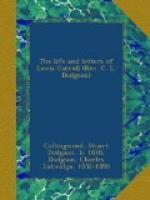On January 16th he saw “New Men and Old Acres” at the Court Theatre. The two authors of the pieces, Dubourg and Tom Taylor, were great friends of his. “It was a real treat,” he writes, “being well acted in every detail. Ellen Terry was wonderful, and I should think unsurpassable in all but the lighter parts.” Mr. Dodgson himself had a strong wish to become a dramatic author, but, after one or two unsuccessful attempts to get his plays produced, he wisely gave up the idea, realising that he had not the necessary constructive powers. The above reference to Miss Ellen Terry’s acting is only one out of a countless number; the great actress and he were excellent friends, and she did him many a kindness in helping on young friends of his who had taken up the stage as a profession.
[Illustration: Tom Taylor. From a photograph by Lewis Carroll.]
She and her sister, Miss Kate Terry, were among the distinguished people whom he photographed. The first time he saw the latter actress was, I think, in 1858, when she was playing in “The Tempest” at the Princess’s. “The gem of the piece,” he writes, “was the exquisitely graceful and beautiful Ariel, Miss Kate Terry. Her appearance as a sea-nymph was one of the most beautiful living pictures I ever saw, but this, and every other one in my recollection (except Queen Katherine’s dream), were all outdone by the concluding scene, where Ariel is left alone, hovering over the wide ocean, watching the retreating ship. It is an innovation on Shakespeare, but a worthy one, and the conception of a true poet.”
[Illustration: Kate Terry. From a photograph by Lewis Carroll.]
Mr. Dodgson was a frequent contributor to the daily Press. As a rule his letters appeared in the St. James’s Gazette, for the editor, Mr. Greenwood, was a friend of his, but the following sarcastic epistle was an exception:—
NATURAL SCIENCE AT OXFORD.
To the Editor of the “Pall Mall Gazette."
Sir,—There is no one of the many ingenious appliances of mechanical science that is more appreciated or more successfully employed than the wedge; so subtle and imperceptible are the forces needed for the insertion of its “thin end,” so astounding the results which its “thick end” may ultimately produce. Of the former process we shall see a beautiful illustration in a Congregation to be holden at Oxford on the 24th inst., when it will be proposed to grant, to those who have taken the degrees of bachelor and master in Natural Science only, the same voting powers as in the case of the “M.A.” degree. This means the omission of one of the two classical languages, Latin and Greek, from what has been hitherto understood as the curriculum of an Oxford education. It is to this “thin end” of the wedge that I would call the attention of our non-residents, and of all interested in Oxford education, while the “thick end” is still looming in the distance. But why fear a “thick




